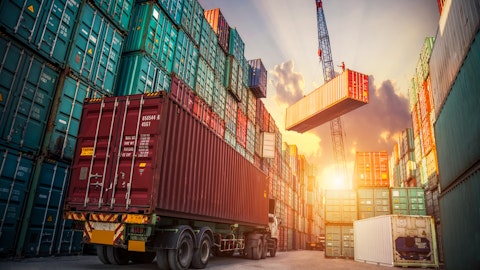Kevin Beth: So just if I’m understanding you’re asking of their revenue, how much was organic growth of the acquisition?
Phillip Yeager: Yes. I mean, I’ll take a shot at that. I think the organic growth on our existing business would have been high mid, high single digits on a year-over-year basis. And we’ve seen some spring surge, which has been been great. Obviously, with the addition of the acquisition, that’s been much higher, and a very large incremental growth. When we think about cross-sell, we are ahead of schedule. We had some overlapping customers that we’re getting deeper with. And then we were able to open some doors with new clients where we did not have an appliance offering before. Some of those wins have already started. Others, I would say, and the vast majority, are still kind of in that contract phase and are in a start-up process right now. So that will start to really see the benefits of the cross-sell, I think as the year progresses, and we get into kind of the Q3, Q4 timeframe.
Bruce Chan: Okay, perfect. Yes, that was exactly what I was looking for. And then just maybe a little bit more broadly, I know diversification of the model has been a real focus for you recently, and I know that we’re still somewhat fresh from Final Mile. But when you think about additional M&A, are you back in the market at this point? If so, are there any areas that you’ve identified as focuses maybe on the intermodal dray side? If properties become available there and maybe more on the retail consolidation, but any color there would be great.
Phillip Yeager: Yes, I think if you look at our free cash flow generation and balance sheet, and we’ve gotten quite good at integrations at this point, or at least we feel we have. And so I think we are back in the market. We’re certainly looking and are active. But we’re always going to be opportunistic when it comes to intermodal. That’s a core part of our business, and anything we can find a direct strategic growth there, we would be very interested in. But the focus it continues to be on really building out that non-asset logistics platform. We feel that we have the right services, but it’s now about adding specializations or scale to those. And I think that will continue to be the focus for us. So certainly you mentioned retail consolidations, Final Mile, I think intermodal, obviously, it’s very interesting.
You look at brokerage. I think we’re kind of at a bottom here in the market which could be very interesting for us. So we have targets that we are really focused on. But really have a great pipeline, and I’m pretty pleased with how our team is doing in identifying new opportunities and vetting them very quickly.
Operator: Our next question comes from Ravi Shanker of Morgan Stanley.
Christyne McGarvey: Hey, great. This is Christyne McGarvey on for Ravi Shanker. Thanks for taking the question. I wanted to draw on your comment earlier in the call about kind of trough to trough earnings being double. Maybe just taking a step back, I think there’s been a lot of changes at the company, and the cycles have been so volatile in the last couple of years that it gets a bit difficult to triangulate to kind of normalized earnings power. And maybe just talk to us a little bit how you guys think about the normalized earnings power of the company as it stands today?
Phillip Yeager: Well, sure. I think I totally agree with you. I think the COVID pandemic there led to some supply chain disruptions. But I think they really led to some over earning and right. And I think that’s okay to say. I mean, you look at how our boxes were being used basically for storage and there wasn’t enough warehousing space. I mean that that was, I think, an anomaly. But at the same time, I think it has led to what is now a prolonged down cycle. And so we feel as though the highs were higher and the lows are lower. So there is a normalized earnings that is that it’s likely to come in the middle, and igher than where we are today. If you think about mid-cycle margins, we think our IPS margin could get back into that mid-to-high single digit level in a normalized sort of market.
And then our logistics margins will stay in this kind of mid-to-higher single digit margin level while revenue was increasing. And so I think the other piece that we’ve tried to highlight, though, is just the cash earnings power of the business, and that puts us in a position to make some strategic investments. But also, as we’ve highlighted, return more capital to shareholders.
Christyne McGarvey: Great, thanks. That’s really helpful to think through. If I could just squeeze in one more near term, you called out also the beginning of the call, the capacity. I think that’s probably one of the bigger surprises of this cycle, just how long capacity has been able to hold on here. So just would be curious what you guys are seeing there? A little bit more color on, you know, some data actually suggesting net additions right now, which seems hard to believe. So would just be curious what you guys are seeing on that? And what do you think kind of finally pushes some of that capacity out of market?
Phillip Yeager: Yes, we are seeing capacity exit at least in what we’re looking at. I think, not at a rate that we would have anticipated at this point in time, which is, I think a big part of why we said we just don’t think that the opportunity to raise price is going to be there really in the back half of the year as we had it originally hope so. Yes, I think that we will see some more capacity exits. I think in the intermodal space, we’re remaining disciplined on redeploying back capacity. I don’t think anybody’s chasing that. I think it’s more about are you going to get the right business at the right returns? And so I think for us, we’re also really only investing in our tractor fleet right now to make sure we maintain the age of our fleet, and any driver additions are really around making sure we maintain share of our drayage percentage as we drive growth.
So I don’t anticipate you’re going to see a whole lot of capacity entering the market at this point in time. And you’ll likely see CapEx constrained from large carriers like us for the next couple of years just because of the excess, but it’s still out there.
Operator: Our next question comes from David Zazula of Barclays.
David Zazula: Hey, this is David Zazula from Barclays. Appreciate you taking the question. I just saw on the incremental volume you’re getting in intermodal, if you could talk at least qualitatively about the operating income per unit profile relative to kind of the existing book of business you are laying on top of, I’m just trying to get a feel for what you’re getting in the incremental volume. And more broadly on how you think of the returns you’re getting on assets, and kind of what would make you think of investing in additional asset sales as the cycle turns?
Brian Alexander: Sure yes, I’ll get us started here. This is Brian. I think as we went into this bid season, we went in with our approach that we’re going to continue to be focused on cost improvements on the rail, on the street, with our container turns. And a big part of that too, was maintaining balance in our network and letting the velocity continue to have a good flow through. I think a part of that, too, we stay focused on a margin per load day, and that helps us go after the over the road conversions that we need to, and we’ve mentioned in the local east. So we’re we feel that we’ve got the right disciplined around it. And what we stayed focused on the cost to maintain the yield discipline, to approach those competitive bids with the right price to win.
Kevin Beth: And as far as purchasing more capacity, we definitely have our ROIC goals, and we stick to those and make those decisions. We do have a great partner as far as our manufacturer of our containers, and we do believe we can get those pretty quickly, if we needed to. So, until we see an inflection in the market. No, we don’t anticipate any additional container purchase.
David Zazula: Very helpful. And if I could just get a follow up, you did talk a little bit about the cost programs. Wonder if you could give a little more color on the employee costs. It seems like you’re doing actually a pretty reasonable job given the inflation we’re seeing in the market, and keeping employee costs low. So anything you’re doing as far as trying to keep that in check, and keep the margin up?
Kevin Beth: Yes, sure. One of the things — our tech, we developed tech with a purpose, and one of those purposes is certainly employee efficiency. And really across the board, all of our different lines of businesses, we’ve been able to use less employees and handle more loads per employee. So if you were to look at our legacy headcount year over year, so this would be without the new Final Mile business, our non-driver non warehouse employee count actually went down 9%. So we do think that those efforts have paid off and we’re able to control costs on an overhead basis.
Operator: Thank you. I would now like to turn the conference back to Phil Yeager for closing remarks.
Phillip Yeager: Great. Well, thank you very much for joining our call this evening. And Kevin, Brian and I are available as always to answer any questions
Operator: Ladies and gentlemen, this concludes today’s conference call with Hub Group, Inc. Thank you for joining. You may now disconnect.
Follow Hub Group Inc. (NASDAQ:HUBG)
Follow Hub Group Inc. (NASDAQ:HUBG)
Receive real-time insider trading and news alerts




